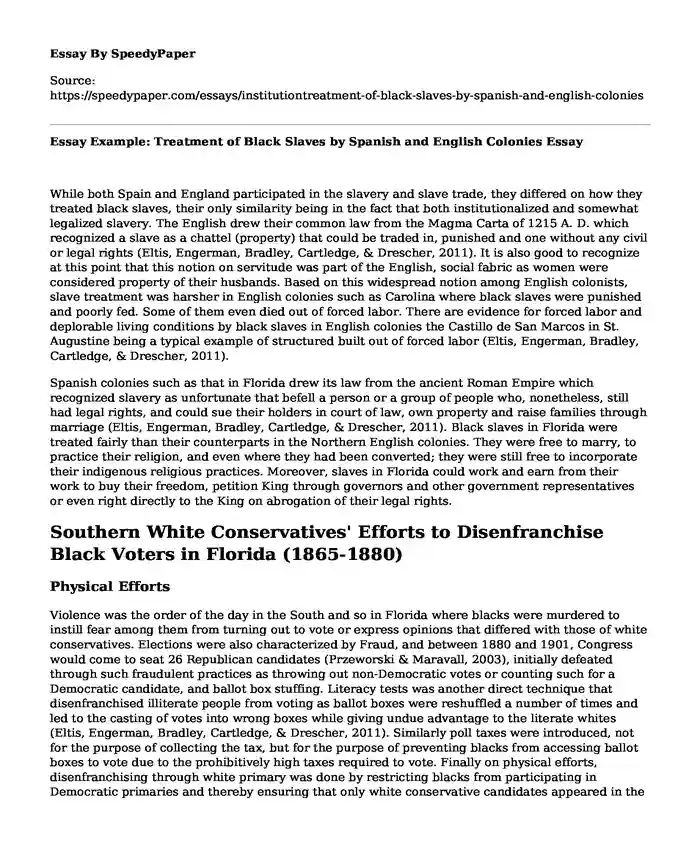While both Spain and England participated in the slavery and slave trade, they differed on how they treated black slaves, their only similarity being in the fact that both institutionalized and somewhat legalized slavery. The English drew their common law from the Magma Carta of 1215 A. D. which recognized a slave as a chattel (property) that could be traded in, punished and one without any civil or legal rights (Eltis, Engerman, Bradley, Cartledge, & Drescher, 2011). It is also good to recognize at this point that this notion on servitude was part of the English, social fabric as women were considered property of their husbands. Based on this widespread notion among English colonists, slave treatment was harsher in English colonies such as Carolina where black slaves were punished and poorly fed. Some of them even died out of forced labor. There are evidence for forced labor and deplorable living conditions by black slaves in English colonies the Castillo de San Marcos in St. Augustine being a typical example of structured built out of forced labor (Eltis, Engerman, Bradley, Cartledge, & Drescher, 2011).
Spanish colonies such as that in Florida drew its law from the ancient Roman Empire which recognized slavery as unfortunate that befell a person or a group of people who, nonetheless, still had legal rights, and could sue their holders in court of law, own property and raise families through marriage (Eltis, Engerman, Bradley, Cartledge, & Drescher, 2011). Black slaves in Florida were treated fairly than their counterparts in the Northern English colonies. They were free to marry, to practice their religion, and even where they had been converted; they were still free to incorporate their indigenous religious practices. Moreover, slaves in Florida could work and earn from their work to buy their freedom, petition King through governors and other government representatives or even right directly to the King on abrogation of their legal rights.
Southern White Conservatives' Efforts to Disenfranchise Black Voters in Florida (1865-1880)
Physical Efforts
Violence was the order of the day in the South and so in Florida where blacks were murdered to instill fear among them from turning out to vote or express opinions that differed with those of white conservatives. Elections were also characterized by Fraud, and between 1880 and 1901, Congress would come to seat 26 Republican candidates (Przeworski & Maravall, 2003), initially defeated through such fraudulent practices as throwing out non-Democratic votes or counting such for a Democratic candidate, and ballot box stuffing. Literacy tests was another direct technique that disenfranchised illiterate people from voting as ballot boxes were reshuffled a number of times and led to the casting of votes into wrong boxes while giving undue advantage to the literate whites (Eltis, Engerman, Bradley, Cartledge, & Drescher, 2011). Similarly poll taxes were introduced, not for the purpose of collecting the tax, but for the purpose of preventing blacks from accessing ballot boxes to vote due to the prohibitively high taxes required to vote. Finally on physical efforts, disenfranchising through white primary was done by restricting blacks from participating in Democratic primaries and thereby ensuring that only white conservative candidates appeared in the federal elections (Przeworski & Maravall, 2003).
Political Efforts
On the other hand, political efforts took an implicit approach to sabotage efforts of blacks to have a political impact through their votes. Ballot box stuffing, for instance, a white candidate preferably a Democrat would have more than one vote submitted to his box fraudulently to win the elections when only a single vote was legally allowed in the ballot (Kousser). Gerrymandering was another political effort in which, in the process of setting district boundaries, an attempt to give Democrats numeric advantage during elections was ensured by manipulating such boundaries to the advantage of the party and its candidates (Kousser). Finally, when all these efforts at ballot box had failed and a black representative (whether white or black in descent), was likely to be stripped of his powers in the supremacy wars so that his occupancy of office had no political impact.
References
Eltis, D., Engerman, S., Bradley, K., Cartledge, P., & Drescher, S. (2011). The Cambridge world history of slavery. Cambridge: Cambridge University Press.
Holmes, W. & Kousser, J. The Shaping of Southern Politics: Suffrage Restriction and the Establishment of the One-Party South, 1880-1910. The Journal Of Southern History, 41(2), 270. http://dx.doi.org/10.2307/2206040
Przeworski, A. & Maravall, J. (2003). Democracy and the rule of law. Cambridge, UK: Cambridge University Press.
Cite this page
Essay Example: Treatment of Black Slaves by Spanish and English Colonies. (2019, Nov 20). Retrieved from https://speedypaper.net/essays/institutiontreatment-of-black-slaves-by-spanish-and-english-colonies
Request Removal
If you are the original author of this essay and no longer wish to have it published on the SpeedyPaper website, please click below to request its removal:
- Free Essay Sample on Power and Leadership
- Wellness on Tobacco. Free Essay Example.
- Economics Essay Example on the City of Merced
- Carbon Credits, Free Essay Example
- Article Review Essay Sample: American in the Gilded Age
- Paper Example on Management Issues as an Ethical Issue
- Effects of Media Violence on Children - Paper Sample
Popular categories





